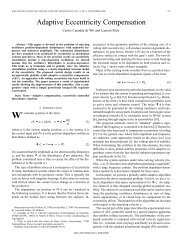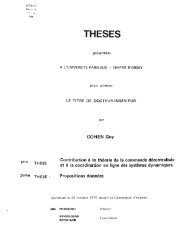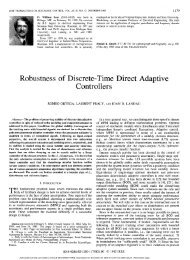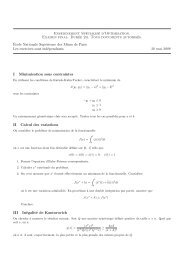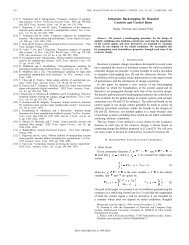(4.8)Step 3. Selection <strong>of</strong> k. Note thatHOMOGENEOUS OBSERVER DESIGN 1831∂V i+1∂X i+1(X i+1 )[S i+1 X i+1 + B i+1 φ i+1 (X i+1 )] = T 1 (X i+1 ) − kT 2 (X i+1 ) ,with the functions T 1 and T 2 defined asT 1 (X i+1 )= ∂V i+1(X i+1 )[S i X i + B i X i+1)]∂X i(T 2 (X i+1 )=Xd V0 −r 0,i+1r 0,i+1i+1 − φ i (X i )d V0 −r 0,i+1r 0,i+1+ Xd V∞ −r ∞,i+1r ∞,i+1i+1 − φ i (X i )d V∞ −r ∞,i+1r ∞,i+1)φ i+1 (X i+1 ) .By the definition <strong>of</strong> homogeneity in the bi-limit and Proposition 2.10, these functionsare homogeneous in the bi-limit with weights (r 0,1 ,...,r 0,i+1 ) and (r ∞,1 ,...,r ∞,i+1 )and degrees d V0 + d 0 and d V∞ + d ∞ . Moreover, since φ i+1 (X i+1 ) has the same sign asX i+1 − φ i (X i ), T 2 (X i+1 ) <strong>is</strong> nonnegative for all X i+1 in R i+1 and, as φ i+1 (X i+1 )=0only if X i+1 − φ i (X i ) = 0, we getT 2 (X i+1 ) = 0 =⇒ X i+1 = φ i (X i ) ,X i+1 = φ i (X i ) =⇒ T 1 (X i+1 )= ∂V i∂X i(X i )[S i X i + B i φ i (X i )] .Consequently, equations (4.7) yield{Xi+1 ∈ R i+1 \{0} : T 2 (X i+1 )=0 } ⊆ { X i+1 ∈ R i+1 : T 1 (X i+1 ) < 0 } .The same implication holds for the homogeneous approximations <strong>of</strong> the two functionsat infinity and around the origin, i.e.,{Xi+1 ∈ R i+1 \{0} : T 2,0 (X i+1 )=0 } ⊆ { X i+1 ∈ R i+1 : T 1,0 (X i+1 ) < 0 } ,{Xi+1 ∈ R i+1 \{0} : T 2,∞ (X i+1 )=0 } ⊆ { X i+1 ∈ R i+1 : T 1,∞ (X i+1 ) < 0 } .Hence, <strong>by</strong> Lemma 2.13, there ex<strong>is</strong>ts k ∗ > 0 such that, for all k ≥ k ∗ , we have for allX i+1 ≠ 0,∂V i+1(X i+1 )[S i+1 X i+1 + B i+1 φ i+1 (X i+1 )] < 0 ,∂X i+1∂V i+1,0(X i+1 )[S i+1 X i+1 + B i+1 φ i+1,0 (X i+1 )] < 0 ,∂X i+1∂V i+1,∞(X i+1 )[S i+1 X i+1 + B i+1 φ i+1,∞ (X i+1 )] < 0 .∂X i+1Th<strong>is</strong> implies that the origin <strong>is</strong> a globally asymptotically stable equilibrium <strong>of</strong> thesystems (4.4).To construct the function φ n it <strong>is</strong> sufficient to iterate the construction in Theorem4.1 starting fromφ 1 (X 1) = ψ 1 (X 1) 1α 1 , ψ 1 (X 1) =−k 1∫ X 1with k 1 > 0.0()H |s| α1 r 0,2rr −1 α ∞,20,1, |s|1 r −1 ∞,1ds ,<strong>Copyright</strong> © <strong>by</strong> <strong>SIAM</strong>. <strong>Unauthorized</strong> <strong>reproduction</strong> <strong>of</strong> <strong>th<strong>is</strong></strong> <strong>article</strong> <strong>is</strong> prohibited.
1832 V. ANDRIEU, L. PRALY, AND A. ASTOLFIAt the end <strong>of</strong> the recursive procedure, we have that the origin <strong>is</strong> a globally asymptoticallystable equilibrium <strong>of</strong> the systems(4.9)X n = S n X n + B n φ n (X n ) ,X n = S n X n + B n φ n,0 (X n ) ,X n = S n X n + B n φ n,∞ (X n ) .Remark 4.2. Note that if d 0 ≥ 0 and d ∞ ≥ 0, then we can select α i = 1 for all1 ≤ i ≤ n, and if d 0 ≤ 0 and d ∞ ≥ d 0 , then we can select α i = r0,1r 0,i+1. Finally, ifd ∞ ≤ 0 and d 0 ≥ d ∞ , then we can select α i =r∞,1r ∞,i+1.Remark 4.3. As in the observer design, when d 0 ≤ d ∞ , we have r0,i+1+d0r 0,i+1≤for i =1,...,n and we can replace the function ψ i <strong>by</strong> the simpler functionr ∞,i+1+d ∞r ∞,i+1((4.10) ψ i+1 (X i+1 ) = −k|X αii+1 − φ i(X i ) αi | αi+1 d 0 +r 0,i+1α i r 0,i+1+|X αii+1 − φ i(X i ) αi | αi+1 d∞+r ∞,i+1)α i r ∞,i+1Finally, if 0 ≤ d 0 ≤ d ∞ , then <strong>by</strong> taking α i = 1 (see Remark 4.2) and φ(X i+1 ) =ψ i+1 (X i+1 ) as defined in (4.10), we recover the design in [1].Example 4.4. Consider a chain <strong>of</strong> integrators <strong>of</strong> dimension two with weights anddegrees(r 0 , d 0 ) =()(2 − q, 1), q− 1 , (r ∞ , d ∞ ) =()(2 − p, 1), p− 1 ,with 2 > p > q > 0. Given k 1 > 0, using the proposed backstepping procedure weobtain a positive real number k 2 such that the feedback∫ X 1−φ i(X 1)(4.11) φ 2 (X 1, X 2) =−k 2 H ( |s| q−1 , |s| p−1) ds ,0∫ Xwith φ 1 (X 1) =−k11 H(|s| q−1 p−12−q0 , |s|2−p ) ds, renders the origin a globally asymptoticallystable equilibrium <strong>of</strong> the closed-loop system. Furthermore, as a consequence <strong>of</strong>the robustness result in Corollary 2.22, there <strong>is</strong> a positive real number c G such that, ifthe positive real numbers |c 0 | and |c ∞ | associated with δ i in (1.2) are smaller than c G ,then the control law φ 2 globally asymptotically stabilizes the origin <strong>of</strong> system (1.1).5. Application to nonlinear output feedback design.5.1. Results on output feedback. The tools presented in the previous sectionscan be used to derive two new results on stabilization <strong>by</strong> output feedback for theorigin <strong>of</strong> nonlinear systems. The output feedback <strong>is</strong> designed for a simple chain <strong>of</strong>integrators,(5.1) ẋ = S n x + B n u, y = x 1 ,where x <strong>is</strong> in R n , y <strong>is</strong> the output in R, and u <strong>is</strong> the control input in R. It <strong>is</strong> thenshown to be adequate to solve the output feedback stabilization problem for the origin<strong>of</strong> systems for which <strong>th<strong>is</strong></strong> chain <strong>of</strong> integrators can be considered as the dominant part<strong>of</strong> the dynamics..<strong>Copyright</strong> © <strong>by</strong> <strong>SIAM</strong>. <strong>Unauthorized</strong> <strong>reproduction</strong> <strong>of</strong> <strong>th<strong>is</strong></strong> <strong>article</strong> <strong>is</strong> prohibited.
- Page 1 and 2: SIAM J. CONTROL OPTIM.Vol. 47, No.
- Page 3 and 4: 1816 V. ANDRIEU, L. PRALY, AND A. A
- Page 5 and 6: 1818 V. ANDRIEU, L. PRALY, AND A. A
- Page 7 and 8: 1820 V. ANDRIEU, L. PRALY, AND A. A
- Page 9 and 10: 1822 V. ANDRIEU, L. PRALY, AND A. A
- Page 11 and 12: 1824 V. ANDRIEU, L. PRALY, AND A. A
- Page 13 and 14: 1826 V. ANDRIEU, L. PRALY, AND A. A
- Page 15 and 16: 1828 V. ANDRIEU, L. PRALY, AND A. A
- Page 17: 1830 V. ANDRIEU, L. PRALY, AND A. A
- Page 21 and 22: 1834 V. ANDRIEU, L. PRALY, AND A. A
- Page 23 and 24: 1836 V. ANDRIEU, L. PRALY, AND A. A
- Page 25 and 26: 1838 V. ANDRIEU, L. PRALY, AND A. A
- Page 27 and 28: 1840 V. ANDRIEU, L. PRALY, AND A. A
- Page 29 and 30: 1842 V. ANDRIEU, L. PRALY, AND A. A
- Page 31 and 32: 1844 V. ANDRIEU, L. PRALY, AND A. A
- Page 33 and 34: 1846 V. ANDRIEU, L. PRALY, AND A. A
- Page 35 and 36: 1848 V. ANDRIEU, L. PRALY, AND A. A
- Page 37: 1850 V. ANDRIEU, L. PRALY, AND A. A




